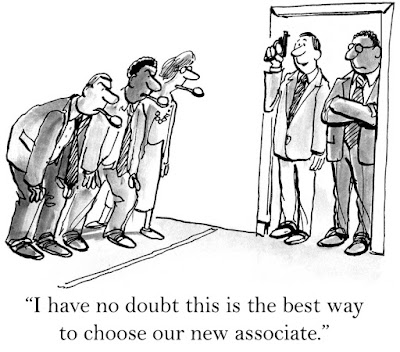OK, so presumably you have a more sophisticated process for interviewing and evaluating candidates than this old-fashioned egg race. But how well do you really get to know your interviewees? Are you confident that your interviewing skills training is helping you to ferret out top talent and guard against hiring a bad employee?
Have you noticed how it seems an even mildly irritating, rude person can have a stronger effect on the environment than the nice guys? It’s actually been proven. Don’t risk the organizational culture you have worked so hard to create with even one toxic personality. It will cost you dearly…not only in the negative vibes they spread but in real dollars. While “A” players add to a company’s profit in terms of productivity, a bad employee erases those gains more than two-fold. And that’s not even counting the decrease in their coworkers’ morale and the negative effect on customers.
So let’s agree that bad hires should be avoided by interviewing with the resolve to ferret out bad candidates who display toxic behaviors regardless of their skills and experience. Basic behavioral interviewing skills training can help with tips like the following:
- Check with every employee who has come in contact with the job candidate. How, for instance, did they treat the receptionist when they were asked to wait? Or how did they interact with the janitor who could have used help opening the door as they were carrying equipment? You want an employee who is naturally courteous with everyone.
- How does the candidate discuss former bosses and coworkers? Do they blame others for their failures? You want a candidate who, though their previous situation may have been difficult, is ready to take responsibility for their share of what went wrong and who is loyal to those who are not present.
- Ask questions that uncover how good they are at building relationships or recognizing areas for improvement. Here are a few that can reveal weaknesses…If I talked to Sara (the candidate’s former boss), what would she say about you? What would you like to improve most about the way you interact with others? Tell me about a time when you were under a great deal of stress and how you handled it. Think of a person you found difficult to work with and tell me how you dealt with the situation.
In each case, probe for further behavior-based competencies so you begin to predict how the candidate would behave in your organization. - Train your team to conduct behavior-based interviews effectively and get them involved. The hire should be a team decision. Establish a structured interviewing process based upon an agreed-upon job profile and see that each interviewer probes for different behaviors and competencies. Set up a common rating scale and then gather to discuss results.
- Check references thoroughly and don’t just ask about technical expertise. Find out about the candidate’s attitude, work ethic and behavior on a team.
Once you accept that talent and skill can’t make up for a difficult-to-work-with employee, you can refine your interviewing process to weed out the folks that won’t fit.


No comments:
Post a Comment